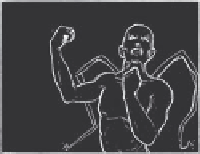Graphics Reference
In-Depth Information
Like many, Keaton had a vaudeville background, and could make his body communicate to the
back of the stalls, both with huge physical stunts and with more subtle gestures. Any form of
acting training is a bonus to animators, and it surprises me that so many do not see this as an
essential part of any training. Of course, there are many animators who come from an acting or
movement background.
Later than Keaton was Jacques Tati in France, a silent comedian existing obstinately in the
brightly coloured full-sound era, and again sharing many principles with animation. Some
of his i lms were shot silently, relying on hysterical but subtle artii cial sound ef ects added
afterwards, as we do in animation. The housewife in
Mon Oncle
is dei ned by the extraordinary
click-clack she makes as she totters around her immaculate house. Her latest gadgets are
made funny by the unexpected sounds they make. They are not the obvious ef ects from a
cartoon, but i nely crafted sounds. Many of Tati's characters are cartoon characters living in a
real world, their shapes and movements subtly distorted. Tati's
Monsieur Hulot
has an unreal
walk full of faltering steps and large strides, but how beautiful it is. Animators strive to i nd
comedy walks like that, but to give a puppet such a walk it would have to be so dei ned so as
not to look like lazy animation. Again, humans try to be unrealistic and animators try to be,
well not realistic, but recognisable. I would encourage animators to watch Tati's gentle physical
buf oonery and slapstick. His gags work more through repetition, building to lyrical chaos. Tati's
pacing is slower than the silents, which often had to cram everything into two reels, but this is
their charm. Tati's i lms always integrate a jaunty, oh so French music score. These i lms are an
acquired taste, but I adore them, especially
Playtime
, an epic about a very mechanical ordered
society, with a restaurant scene that is a masterclass of structured chaos.
If there's a modern-day descendant it would be Rowan Atkinson's Mr Bean character, and how
ironic that the character is kept alive now in an animated series. The year 2007 even saw the
release of
Mr Bean's Holiday
, surely a direct homage to the
Monsieur Hulot's Holiday
by Jacques
Tati. I don't warm to his constant gurning as much as I do to his rubber limbs.
I prefer to use the whole body in animation rather than relying on facial gurning. Whenever I
have acted my face seems to be doing too much, led by a pair of eyebrows giving their own
independent performances. Maybe because I feel have a face for radio and a voice for mime,
I feel uncomfortable depending on the voice and face for performance. With actors on stage
unable to rely on close-ups for their expressions, and using their bodies more, perhaps that
is why I enjoy theatre. It's probably because I appreciate movement more than anything. I'm
more responsive to the i lms of Fred Astaire and Gene Kelly than to most modern i lm musicals,
where much of the movement is created in editing. Admittedly blown away by the sheer
bravado of
Moulin Rouge
and
Chicago
, the fast paced editing annoyed me, as I felt cheated of
seeing the dancers using their bodies to sustain long takes, which is much of the appeal of
dancing. Astaire and Kelly often shot their numbers in long l uid takes, with the whole of their
bodies completely visible. They both enjoyed camera tricks and probably would have jumped
at the chance to utilise any computer trickery today, but I have a feeling they
would still have been i lming themselves full length.
Jerky movements
Not all movement is perfect for stop motion. As I write, dozens of birds are sitting
on a tree outside, their heads twitching back and forth in startling jerky and sharp


Search WWH ::

Custom Search